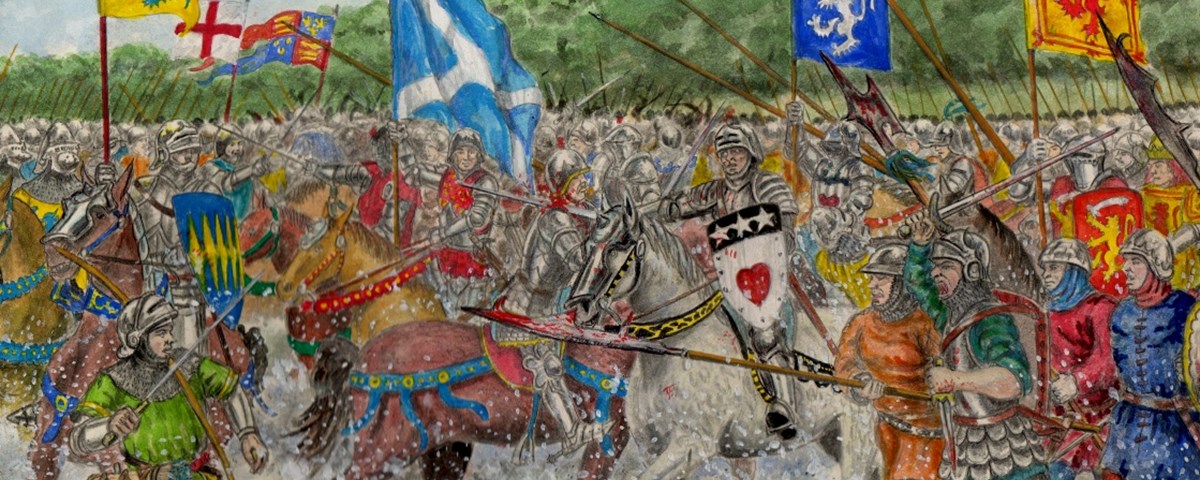
‘Scots taunt the Engish forces into deep water at the River Sark. Conjectural reconstruction by Andrew Spratt, 1984.’ Copyright @ Andrew Spratt
EDINBURGH, SCOTLAND, 2016-Aug-15 — /Travel PR News/ — A battlefield to the southwest of Gretna in Dumfries and Galloway has become the 40th site to be added to the Inventory of Historic Battlefields.
The Battle of Sark, fought in 1448, was the first decisive victory for a Scottish force over the English since the Battle of Otterburn, 60 years earlier, and the final pitched battle between the two countries in the period of the Hundred Years War.
Philip Robertson, Historic Environment Scotland’s Deputy Head of Designations for battlefields, said: “The Inventory raises awareness about important battlefield sites which add to our understanding of Scotland’s archaeology and history. Following an application from a member of the public, we carried out further research into the Battle of Sark, and found that it met the criteria to be added to the inventory. The battle was fought during a fascinating and tumultuous period of Scottish history, and we hope that by adding it to the inventory we will raise awareness of the battlefield site, stimulate further research around it, and develop its potential as an educational resource and site for visitors.”
The background to the battle was a brief period of relative peace between England and Scotland, abruptly brought to an end in late 1448 by the decision of Henry Percy, 2nd Earl of Northumberland to invade Scotland with a force reported to be around 6,000 men. He did so with the blessing of the English king Henry V. His plan was to ransack the lands of the Douglas family. He made camp in the area adjacent to modern Gretna and dispatched scouting and raiding parties to the surrounding area.
Near the end of October, Northumberland’s army was met by a Scottish force of 4,000 men led by Hugh Douglas, Earl of Ormonde. Although the English army were warned of Ormonde’s advance and able to deploy for battle in time to meet the Scots, the battle soon became a rout after the English archers were neutralised and the main Scottish army was able to advance on Northumberland’s forces, who were now cornered by three watercourses – the Esk, the Sark, and the Kirtle Water. Hemmed in on three sides, the English soldiers were unable to easily retreat and many were reported to have been drowned in the Esk.
Although the victory was a decisive one for the Scots, the battle did little to alter the landscape of internal conflict in the Kingdoms on both sides of the Borders, other than to greatly increase the prominence of the already powerful Douglas family in Scottish politics. The Earl of Northumberland was able to escape the conflict.
The Inventory of Historic Battlefields was created in 2011 and is a major resource for enhancing the understanding and appreciation of battlefields, as well as promoting education and stimulating further research on the topic. It helps with the protection and management of battlefields.
The Inventory is maintained by Historic Environment Scotland. Anybody can apply for a battlefield to be designated. Information on how to do this can be found at https://www.historicenvironment.scot/advice-and-support/listing-scheduling-and-designations/battlefields/
For more information on designations, including battlefields, visit the Historic Environment Scotland designations portal.
About Historic Environment Scotland
- As of the 1st October 2015, Historic Scotland and RCAHMS came together to form a new lead public body charged with caring for, protecting and promoting the historic environment. The new body Historic Environment Scotland (HES) will lead on delivering Scotland’s first strategy for the historic environment, Our Place in Time.
- Historic Scotland is a sub brand of Scotland’s new public heritage body, Historic Environment Scotland
- Historic Environment Scotland is a registered Scottish Charity. Scottish Charity No. SC045925
- You can keep up to date with news from Historic Environment Scotland and register for media release email alerts here. If you wish to unsubscribe, please contact us.
Year of Innovation, Architecture and Design 2016
- 2016 will shine a spotlight on Scotland’s achievements in innovation, architecture and design through a wide-ranging, variety of new and existing activity.
- The Year of Innovation, Architecture and Design started on 1 January 2016 and will end on 31 December 2016. It will build on the momentum generated by the current 2015 Year of Food and Drink as well as previous years including Homecoming Scotland 2014, the Year of Creative and the Year of Natural.
- Through a series of exciting events and activity, the year will showcase Scotland’s position as an “innovation nation”, its outstanding built heritage, and its thriving, internationally acclaimed creative industries sector.
- The Year of Innovation, Architecture and Design is a Scottish Government initiative being led by VisitScotland, and supported by a variety of partners including Scottish Government, Creative Scotland, Architecture + Design Scotland, Scottish Tourism Alliance, Scottish Enterprise, The National Trust for Scotland, Historic Environment Scotland, Highlands and Islands Enterprise and The Royal Incorporation of Architects in Scotland (RIAS).
- The Year of Innovation, Architecture and Design events fund is managed by EventScotland, part of VisitScotland’s Events Directorate.
Follow Historic Environment Scotland
Twitter:
@HistEnvScot
@welovehistory
@edinburghcastle
@stirlingcastle
@ScottishTen
Facebook:
Historic Environment Scotland;
Historic Scotland
Instagram
LinkedIn
Pinterest
YouTube
Blogs:
Historic Environment Scotland
Historic Scotland Chain Mail
Stirling Castle
Edinburgh Castle
Climate Change
For further information
Alan Bannon
Historic Environment Scotland Media Office
Direct Line: 0131 668 8588
Mobile: 07854 366 805
alan.bannon@hes.scot

